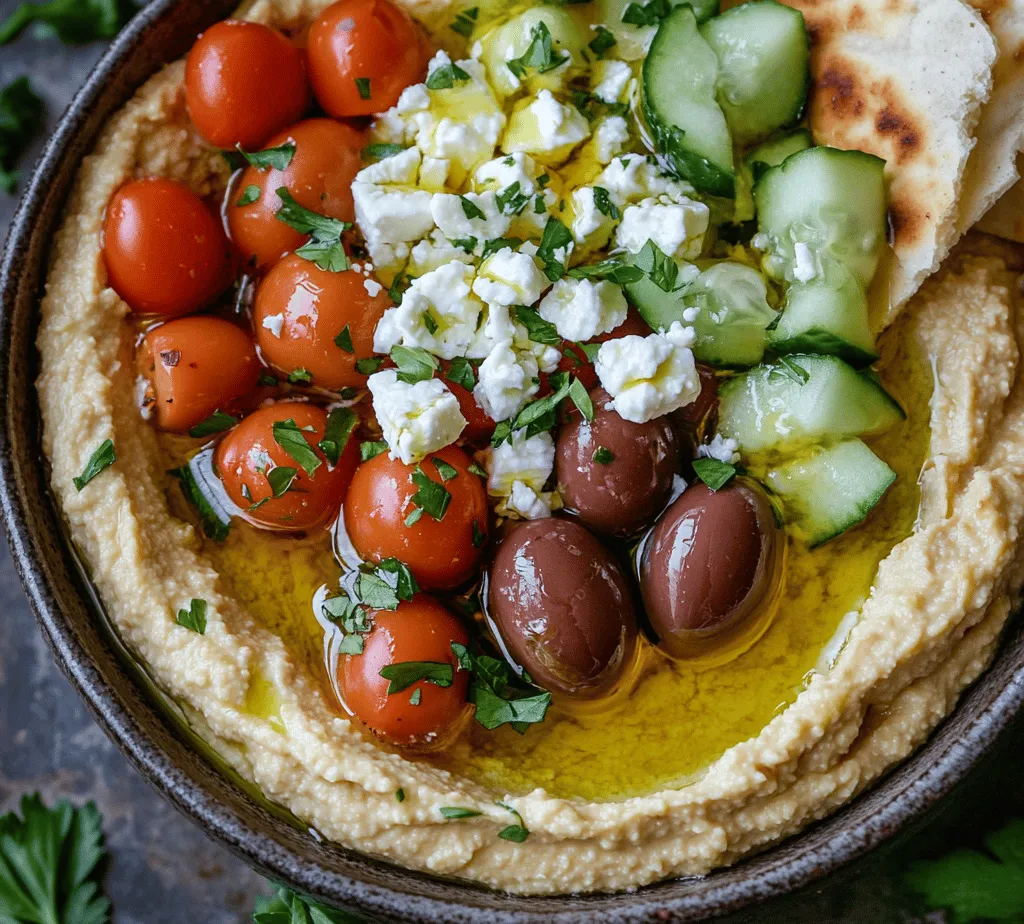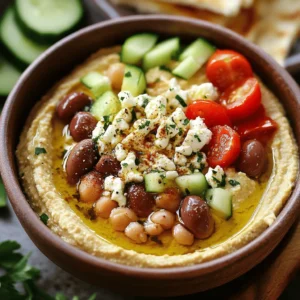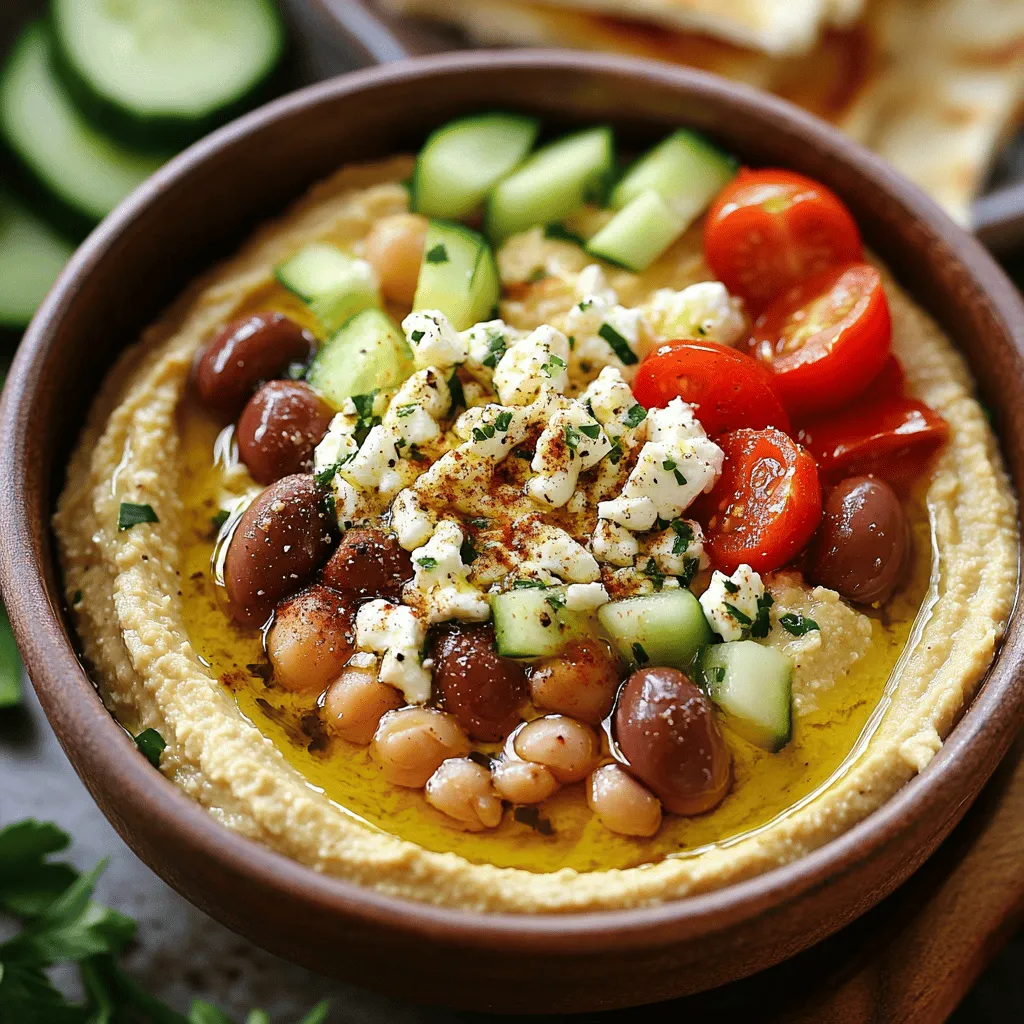Introduction
Greek style loaded hummus is a vibrant, flavorful dip that brings together the rich culinary traditions of Greece and the Middle East. Known for its creamy texture and robust taste, this delightful dish serves as a perfect appetizer and a nutritious snack that can be enjoyed any time of the day. Packed with protein from chickpeas, creamy tahini, and topped with fresh Mediterranean ingredients, this recipe is sure to impress your family and friends. In this article, we will explore the origins of hummus, the nutritional benefits of its ingredients, and provide a detailed guide on how to make this delicious Greek-style loaded hummus.
Hummus has gained immense popularity worldwide, not just as a dip but also as a versatile spread for sandwiches and wraps. Its appeal lies in its simplicity and the ability to customize it with various toppings, making it an ideal addition to any meal or gathering. The Greek twist on traditional hummus introduces a medley of flavors that enhance its classic essence, creating a dish that is both familiar and exciting.
The Origins of Hummus
Historical Background
Hummus boasts ancient roots in Middle Eastern cuisine, with its history often debated among various cultures. While the exact origin of hummus remains unclear, evidence suggests that it has been enjoyed for centuries, with references dating back to ancient Egyptian times. As trade routes expanded, the dish made its way through the Levant region, gaining popularity in countries like Lebanon, Israel, and Syria. Each culture adapted hummus to incorporate local ingredients and flavors, leading to a rich tapestry of variations.
Over the years, hummus has evolved, with each region contributing its unique touch. In Greece, for example, the addition of olive oil, fresh herbs, and spices complements the creamy base, creating a distinctly Mediterranean flavor profile. This evolution showcases not just the adaptability of hummus but also its role as a bridge between diverse culinary traditions.
The Role of Hummus in Mediterranean Diet
Hummus plays a vital role in the Mediterranean diet, a dietary pattern praised for its health benefits. This diet emphasizes whole foods, healthy fats, and a variety of plant-based ingredients, making it a cornerstone of healthy eating in Greece and the surrounding regions. Hummus, made primarily from chickpeas, is a staple in many Mediterranean households, serving as both a nutritious option and a delicious accompaniment to various meals.
Chickpeas, a primary ingredient in hummus, are rich in protein, fiber, and essential vitamins and minerals. They contribute to satiety, promote digestive health, and can even aid in weight management. Additionally, tahini, the creamy base of hummus, is packed with healthy fats, calcium, and antioxidants, offering a wealth of nutritional benefits. Together, these ingredients create a wholesome dish that not only satisfies your taste buds but also nourishes your body.
Ingredients Breakdown
Chickpeas: The Heart of Hummus
Chickpeas, also known as garbanzo beans, are the heart of hummus. These legumes are renowned for their impressive nutritional profile. A single cup of canned chickpeas contains approximately 15 grams of protein, 12 grams of fiber, and a variety of vitamins and minerals, including folate, iron, and magnesium. Their high fiber content promotes digestive health, while their protein helps build and repair tissues in the body.
Incorporating chickpeas into your diet offers numerous health benefits. They are low in fat and can contribute to weight management by promoting a feeling of fullness. Additionally, chickpeas have a low glycemic index, making them an excellent choice for maintaining stable blood sugar levels. Their versatility allows them to be used in various dishes, from salads to stews, making them a staple for health-conscious eaters.
Tahini: The Creamy Base
Tahini is a key ingredient in hummus, providing its signature creaminess and depth of flavor. Made from ground sesame seeds, tahini is rich in healthy fats, particularly polyunsaturated and monounsaturated fats, which are beneficial for heart health. It also contains essential nutrients such as calcium, iron, magnesium, and B vitamins, making it a nutritious addition to your diet.
The process of making tahini involves grinding toasted sesame seeds into a smooth paste. This versatile ingredient can be used in various dishes beyond hummus, such as salad dressings, marinades, and desserts. Its nutty flavor and creamy texture enhance any dish, making it a favorite among chefs and home cooks alike.
Olive Oil: Adding Flavor and Health
Olive oil is another essential ingredient in Greek style loaded hummus, known for its rich flavor and health benefits. Extra virgin olive oil, in particular, is revered for its high content of antioxidants and anti-inflammatory properties. It is a staple in Mediterranean cooking, enhancing the taste of dishes while contributing to overall health.
The significance of olive oil goes beyond flavor; it plays a crucial role in promoting heart health. Studies have shown that the monounsaturated fats found in olive oil can help reduce bad cholesterol levels and lower the risk of heart disease. Additionally, incorporating olive oil into your diet can improve insulin sensitivity and reduce the risk of type 2 diabetes.
Fresh Vegetables and Toppings
To elevate the Greek style loaded hummus, fresh vegetables and toppings play a pivotal role. Ingredients like ripe tomatoes, cucumbers, and red onions add a burst of freshness and color, enhancing both the aesthetic and flavor of the dish. These vegetables are not only delicious but also packed with essential vitamins and minerals. For instance, tomatoes are an excellent source of vitamin C and antioxidants, while cucumbers provide hydration and fiber.
Kalamata olives and feta cheese are classic toppings that bring a taste of Greece to the hummus. Kalamata olives add a briny richness that complements the creamy base, while feta cheese contributes a salty, tangy flavor that rounds out the dish. Both ingredients are also rich in nutrients, with olives providing healthy fats and feta offering a good source of protein and calcium.
Step-by-Step Instructions for Greek Style Loaded Hummus
Preparing the Base Hummus
Now that we’ve explored the origins and ingredients of Greek style loaded hummus, it’s time to dive into the preparation process. The first step involves making the base hummus, which serves as the foundation for all the delicious toppings you will add later.
1. Gather Your Ingredients: You will need the following ingredients to make the base hummus:
– 1 can (15 oz) of chickpeas, drained and rinsed
– 1/4 cup of tahini
– 2 tablespoons of extra virgin olive oil
– 1-2 cloves of garlic, minced (adjust according to your taste)
– The juice of one lemon
– Salt, to taste
– Water, as needed to achieve desired consistency
2. Combine Ingredients: In a food processor, combine the drained chickpeas, tahini, minced garlic, lemon juice, and salt. Begin to pulse the mixture until it starts to break down and combine.
3. Add Olive Oil: While the food processor is running, drizzle in the extra virgin olive oil. This will help create a creamy texture and infuse the hummus with flavor.
4. Adjust Consistency: To achieve the perfect creamy consistency, gradually add water, one tablespoon at a time, while blending until smooth. Continue blending until the hummus is silky and well-combined.
5. Taste and Adjust: Once the hummus reaches your desired consistency, taste it and adjust the seasoning as necessary, adding more salt, lemon juice, or garlic to suit your preferences.
This base hummus is now ready to be transformed into a Greek style loaded hummus by adding your favorite toppings. The next steps will guide you through creating the perfect finishing touches that will take your hummus to the next level. Stay tuned as we explore the toppings and presentation that make this dish a standout at any gathering.

Detailed Instructions on Blending Chickpeas and Other Base Ingredients
To create the base for your Greek style loaded hummus, start by gathering your ingredients. You will need:
– 1 can (15 oz) of chickpeas, drained and rinsed
– 1/4 cup tahini
– 1/4 cup fresh lemon juice (approximately 1 large lemon)
– 2 tablespoons extra-virgin olive oil
– 1-2 cloves of garlic, minced (depending on your preference)
– 1/2 teaspoon ground cumin
– Salt to taste (about 1/2 teaspoon to start)
– Water as needed for blending
1. Prepare Your Ingredients: Begin by draining and rinsing the canned chickpeas under cold running water. This removes excess sodium and helps achieve a smoother texture.
2. Combine Ingredients in a Blender: In a food processor or high-powered blender, combine the drained chickpeas, tahini, lemon juice, olive oil, minced garlic, ground cumin, and salt.
3. Blend Until Smooth: Start blending the mixture on a low speed, gradually increasing to high. Blend for about 1-2 minutes or until the mixture is creamy. Scrape down the sides of the bowl as needed to ensure all ingredients are well incorporated.
4. Adjust Consistency: If the hummus is too thick, add water a tablespoon at a time, blending until you reach your desired consistency. For a creamier texture, aim for a silky-smooth finish. The addition of water will not only help with texture but also prevent the hummus from becoming too dense.
5. Taste and Adjust Seasoning: Once blended, taste your hummus and adjust the seasoning as necessary. You can add more salt, lemon juice, or garlic depending on your flavor preferences.
Tips for Achieving the Perfect Creamy Texture
Achieving a creamy consistency in hummus is an art. Here are some expert tips to ensure your hummus is perfectly smooth:
– Peel the Chickpeas: For an ultra-smooth texture, consider peeling the skins off the chickpeas before blending. This step is optional but can make a significant difference in creaminess.
– Use Cold Water: When adding water to adjust the consistency, use cold water. It helps keep the hummus cool and maintains the freshness of the ingredients.
– Blend for Longer: Don’t rush the blending process. The longer you blend, the creamier your hummus will become. A high-powered blender is ideal for this task.
– Incorporate Ice Cubes: For an exceptionally creamy and cold hummus, add a few ice cubes while blending. This can also help adjust the consistency without diluting the flavor.
Assembling the Loaded Toppings
Now that your hummus base is ready, it’s time to assemble the loaded toppings that will elevate your dish.
Creating the Well for Yogurt
1. Transfer to Serving Dish: Spoon the blended hummus into a shallow serving dish, spreading it out evenly.
2. Make a Well: Using the back of a spoon, create a shallow well in the center of the hummus. This will be the perfect spot to add your Greek yogurt, which adds creaminess and tang.
Layering the Toppings
1. Add Yogurt: Spoon a generous dollop of Greek yogurt into the well you created in the hummus.
2. Layer with Toppings: Top the yogurt with your choice of ingredients. Consider diced cucumbers, chopped tomatoes, Kalamata olives, crumbled feta cheese, and a sprinkle of fresh herbs like parsley or dill.
3. Drizzle with Olive Oil: Finish off your loaded hummus with a drizzle of extra-virgin olive oil and a pinch of paprika or sumac for added flavor and color.
4. Garnish: For a final touch, garnish with lemon zest and a few whole chickpeas.
Serving Suggestions
Ideal Pairings
Greek style loaded hummus is best enjoyed with various dippers. Here are some ideal pairings:
– Pita Bread: Warm, soft pita bread is the classic accompaniment. Cut it into triangles for easy dipping.
– Pita Chips: For an extra crunch, serve with baked pita chips. They add a delightful texture that complements the creamy hummus.
– Fresh Vegetables: Crisp vegetables such as carrot sticks, cucumber slices, and bell pepper strips not only add color but also a refreshing crunch.
Creative Serving Ideas for Parties and Gatherings
– Hummus Platter: Create a beautiful platter by arranging your loaded hummus alongside an assortment of dips, olives, cheeses, and fresh vegetables. This makes for a stunning centerpiece at gatherings.
– Mini Hummus Cups: For individual servings, scoop hummus into small cups with a dollop of yogurt on top. Garnish with toppings and serve with toothpicks for easy snacking.
– Hummus and Grilled Meats: Serve your loaded hummus as a side with grilled chicken or lamb for a complete Mediterranean meal.
Storage Tips
To ensure your hummus remains fresh and flavorful, follow these best practices for storing leftovers:
– Airtight Containers: Store leftover hummus in an airtight container to prevent it from drying out or absorbing other odors from the fridge.
– Layering with Olive Oil: Before sealing the container, drizzle a thin layer of olive oil over the surface of the hummus. This helps seal in moisture and flavor.
– Consume Within a Week: Homemade hummus can last in the refrigerator for up to one week. However, for the best taste and texture, it is best enjoyed within the first few days.
Nutritional Benefits of Greek Style Loaded Hummus
Rich in Protein and Fiber
Chickpeas are the star ingredient in hummus, providing a significant source of plant-based protein and dietary fiber. Here’s why this matters:
– Protein: Chickpeas contain about 15 grams of protein per cup, making them an excellent meat alternative for vegetarians and vegans.
– Fiber: The high fiber content in chickpeas promotes healthy digestion and helps you feel full longer. Fiber-rich foods are essential for maintaining a balanced diet.
Healthy Fats from Olive Oil and Tahini
The healthy fats present in this dish also contribute to its nutritional profile:
– Olive Oil: Rich in monounsaturated fats, olive oil supports heart health and can help lower bad cholesterol levels.
– Tahini: Made from ground sesame seeds, tahini is also a source of healthy fats as well as protein and minerals like calcium.
Vitamins and Minerals
The toppings added to Greek style loaded hummus enhance its nutritional value further:
– Fresh Vegetables: Ingredients like cucumbers and tomatoes are packed with vitamins A and C, while olives provide antioxidants.
– Herbs: Fresh herbs contribute essential vitamins and enhance flavor without additional calories, making them a smart addition to any dish.
Conclusion
Greek style loaded hummus is more than just a dip; it’s a celebration of Mediterranean flavors and healthful ingredients. This dish not only satisfies your taste buds but also provides a wealth of nutritional benefits, making it a perfect addition to any meal or gathering. By following the simple steps outlined in this article, you can create a delicious, colorful, and nutritious dish that is sure to be a hit with everyone. Enjoy the experience of making and sharing this delightful hummus that embodies the spirit of Greek cuisine!


